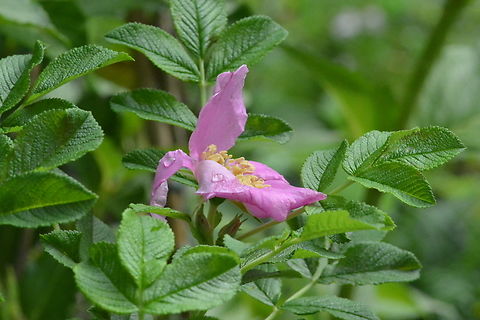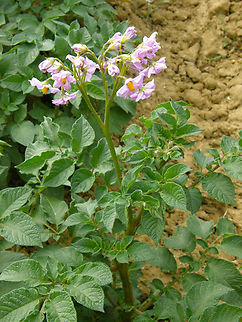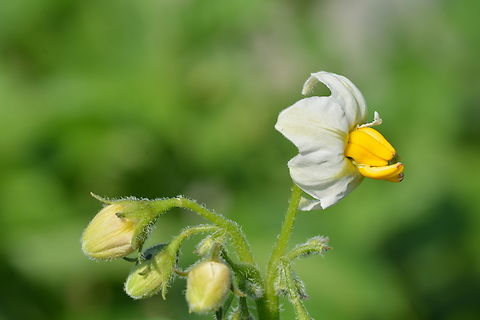
Appearance
Potato plants are herbaceous perennials that grow about 60 cm high, depending on variety, with the leaves dying back after flowering, fruiting and tuber formation. They bear white, pink, red, blue, or purple flowers with yellow stamens. In general, the tubers of varieties with white flowers have white skins, while those of varieties with colored flowers tend to have pinkish skins. Potatoes are mostly cross-pollinated by insects such as bumblebees, which carry pollen from other potato plants, though a substantial amount of self-fertilizing occurs as well. Tubers form in response to decreasing day length, although this tendency has been minimized in commercial varieties.After flowering, potato plants produce small green fruits that resemble green cherry tomatoes, each containing about 300 seeds. Like all parts of the plant except the tubers, the fruit contain the toxic alkaloid solanine and are therefore unsuitable for consumption. All new potato varieties are grown from seeds, also called "true potato seed", "TPS" or "botanical seed" to distinguish it from seed tubers. New varieties grown from seed can be propagated vegetatively by planting tubers, pieces of tubers cut to include at least one or two eyes, or cuttings, a practice used in greenhouses for the production of healthy seed tubers. Plants propagated from tubers are clones of the parent, whereas those propagated from seed produce a range of different varieties.

Naming
The English word "potato" comes from Spanish. The Royal Spanish Academy says the Spanish word is a hybrid of the Taíno and the Quechua. The name originally referred to the sweet potato although the two plants are not closely related. The 16th-century English herbalist John Gerard referred to sweet potatoes as "common potatoes", and used the terms "bastard potatoes" and "Virginia potatoes" for the species we now call potato. In many of the chronicles detailing agriculture and plants, no distinction is made between the two. Potatoes are occasionally referred to as "Irish potatoes" or "white potatoes" in the United States, to distinguish them from sweet potatoes.The name "spud" for a small potato comes from the digging of soil prior to the planting of potatoes. The word has an unknown origin and was originally used as a term for a short knife or dagger, probably related to the Latin a word root meaning 'sword'; compare Spanish, English "spade" and "spadroon". It subsequently transferred over to a variety of digging tools. Around 1845, the name transferred to the tuber itself, the first record of this usage being in New Zealand English. The origin of the word "spud" has erroneously been attributed to an 18th-century activist group dedicated to keeping the potato out of Britain, calling itself The Society for the Prevention of Unwholesome Diet. It was Mario Pei's 1949 "The Story of Language" that can be blamed for the word's false origin. Pei writes, "the potato, for its part, was in disrepute some centuries ago. Some Englishmen who did not fancy potatoes formed a Society for the Prevention of Unwholesome Diet. The initials of the main words in this title gave rise to spud." Like most other pre-20th century acronymic origins, this is false, and there is no evidence that a Society for the Prevention of Unwholesome Diet ever existed.

Food
This table shows the nutrient content of potatoes next to other major staple foods, each one measured in its respective raw state, even though staple foods are not commonly eaten raw and are usually sprouted or cooked before eating. In sprouted and cooked form, the relative nutritional and anti-nutritional contents of each of these grains may be different from the values in this table. Each nutrient has the highest number highlighted to show the staple food with the greatest amount in a 100-gram raw portion....table snipped...
A raw yellow dent corn
B raw unenriched long-grain white rice
C raw hard red winter wheat
D raw potato with flesh and skin
E raw cassava
F raw green soybeans
G raw sweet potato
H raw sorghum
Y raw yam
Z raw plantains
/* unofficial
Defense
Potatoes contain toxic compounds known as glycoalkaloids, of which the most prevalent are solanine and chaconine. Solanine is found in other plants in the same family, Solanaceae, which includes such plants as deadly nightshade, henbane and tobacco, as well as the food plants eggplant and tomato. These compounds, which protect the potato plant from its predators, are generally concentrated in its leaves, flowers, sprouts, and fruits. In a summary of several studies, the glycoalkaloid content was highest in the flowers and sprouts and lowest in the tuber flesh.Exposure to light, physical damage, and age increase glycoalkaloid content within the tuber. Cooking at high temperatures—over 170 °C —partly destroys these compounds. The concentration of glycoalkaloids in wild potatoes is sufficient to produce toxic effects in humans. Glycoalkaloid poisoning may cause headaches, diarrhea, cramps, and, in severe cases, coma and death. However, poisoning from cultivated potato varieties is very rare. Light exposure causes greening from chlorophyll synthesis, giving a visual clue as to which areas of the tuber may have become more toxic. However, this does not provide a definitive guide, as greening and glycoalkaloid accumulation can occur independently of each other.
Different potato varieties contain different levels of glycoalkaloids. The Lenape variety was released in 1967 but was withdrawn in 1970 as it contained high levels of glycoalkaloids. Since then, breeders developing new varieties test for this, and sometimes have to discard an otherwise promising cultivar. Breeders try to keep glycoalkaloid levels below 200 mg/kg. However, when these commercial varieties turn green, they can still approach solanine concentrations of 1000 mg/kg. In normal potatoes, analysis has shown solanine levels may be as little as 3.5% of the breeders' maximum, with 7–187 mg/kg being found. While a normal potato tuber has 12–20 mg/kg of glycoalkaloid content, a green potato tuber contains 250–280 mg/kg and its skin has 1500–2200 mg/kg.
Evolution
The potato was first domesticated in the region of modern-day southern Peru and extreme northwestern Bolivia between 8000 and 5000 BC. It has since spread around the world and become a staple crop in many countries.The earliest archaeologically verified potato tuber remains have been found at the coastal site of Ancon, dating to 2500 BC. The most widely cultivated variety, "Solanum tuberosum tuberosum", is indigenous to the Chiloé Archipelago, and has been cultivated by the local indigenous people since before the Spanish conquest.
According to conservative estimates, the introduction of the potato was responsible for a quarter of the growth in Old World population and urbanization between 1700 and 1900. In the Altiplano, potatoes provided the principal energy source for the Inca civilization, its predecessors, and its Spanish successor. Following the Spanish conquest of the Inca Empire, the Spanish introduced the potato to Europe in the second half of the 16th century, part of the Columbian exchange. The staple was subsequently conveyed by European mariners to territories and ports throughout the world. The potato was slow to be adopted by European farmers, but soon enough it became an important food staple and field crop that played a major role in the European 19th century population boom. However, lack of genetic diversity, due to the very limited number of varieties initially introduced, left the crop vulnerable to disease. In 1845, a plant disease known as late blight, caused by the fungus-like oomycete "Phytophthora infestans", spread rapidly through the poorer communities of western Ireland as well as parts of the Scottish Highlands, resulting in the crop failures that led to the Great Irish Famine. Thousands of varieties still persist in the Andes however, where over 100 cultivars might be found in a single valley, and a dozen or more might be maintained by a single agricultural household.
Uses
Potatoes are prepared in many ways: skin-on or peeled, whole or cut up, with seasonings or without. The only requirement involves cooking to swell the starch granules. Most potato dishes are served hot but some are first cooked, then served cold, notably potato salad and potato chips. Common dishes are: mashed potatoes, which are first boiled, and then mashed with milk or yogurt and butter; whole baked potatoes; boiled or steamed potatoes; French-fried potatoes or chips; cut into cubes and roasted; scalloped, diced, or sliced and fried; grated into small thin strips and fried; grated and formed into dumplings, Rösti or potato pancakes. Unlike many foods, potatoes can also be easily cooked in a microwave oven and still retain nearly all of their nutritional value, provided they are covered in ventilated plastic wrap to prevent moisture from escaping; this method produces a meal very similar to a steamed potato, while retaining the appearance of a conventionally baked potato. Potato chunks also commonly appear as a stew ingredient. Potatoes are boiled between 10 and 25 minutes, depending on size and type, to become soft.Cultural
Invented in 1949, and marketed and sold commercially by Hasbro in 1952, Mr. Potato Head is an American toy that consists of a plastic potato and attachable plastic parts, such as ears and eyes, to make a face. It was the first toy ever advertised on television.References:
Some text fragments are auto parsed from Wikipedia.